Verdict
Tiny LEDs, hundreds of dimming zones and thousands of nits of brightness add up to make the TCL C845K on 2023’s best value TVs
Pros
- Incredibly bright for its money
- Impressive contrast for such a bright screen
- Amazingly affordable for so much quality
Cons
- Local dimming system isn’t flawless
- Picture presets need tweaking
- Built-in subwoofer occasionally distorts
-
65-inch 4K LCD screenThe screen carries 3840 x 2160 pixels. It can also show HD content via an AI-driven upscaling engine -
Mini LED LightingMore LEDs can fit in the same screen area to provide more brightness and light control. -
Google TV with Roku stick on requestSupports Google TV, no UK catch-up services so TCL will send a free Roku stick to any who requests one
Introduction
The TCL 65C845K is the stuff of nightmares for the TV ‘establishment’. After all, its 65-inch screen combines premium Mini LED technology with a Quantum Dot colour system and the sort of local dimming zone and brightness numbers you’d normally have to spend a small fortune for, yet only costs £1,049. No other brand can currently offers any TV that’s remotely similar in spec for anywhere near as little money.
All those rival brands can hope for, really, is that the 65C845K’s ground-breaking specifications for its money don’t translate into the sort of performance level I’d normally expect them to.
Availability
In case you haven’t got the point yet, the 65C845K’s price is unprecedented for the level of specification it offers. At £1,049 in the UK and $2,199 in Australia (there’s no direct equivalent for it in the US), it’s more than £500 cheaper than Samsung’s cheapest 65-inch Mini LED TV, £500 cheaper than the most equivalent Hisense Mini LED TV, and more than £1,300 cheaper than Sony’s 65-inch X95L Mini LED TV for 2023.
There are also 55-, 75- and 85-inch C845Ks available, priced at £849, £1,499 and £1,999 respectively. Note that these other sizes likely won’t feature exactly the same specifications as the 65-inch when it comes to dimming zone numbers and brightness.
Making the 65C845K’s price advantage all the more startling is the fact that despite its affordability, it doesn’t just pay lip service to its premium features. Rather, it actually delivers eye-catchingly high-end versions of those features.
Design
- Pretty chunky by today’s standards
- Heavy duty build
- Centrally mounted stand
If you like your TVs skinny, then the TCL 65C845K isn’t for you. At its deepest point – which is basically almost the whole of its bottom half – it sticks out a prodigious 76mm. Enough to make it a challenging option for wall mounting, even though the screen isn’t as heavy as it looks.
The border round the screen is mercifully slim relative to its depth, and its heavy duty, centrally mounted stand supports the slightly plasticky screen pretty robustly. The stand features a detachable cover on the rear of its neck, too, so that you can hide cables in it.
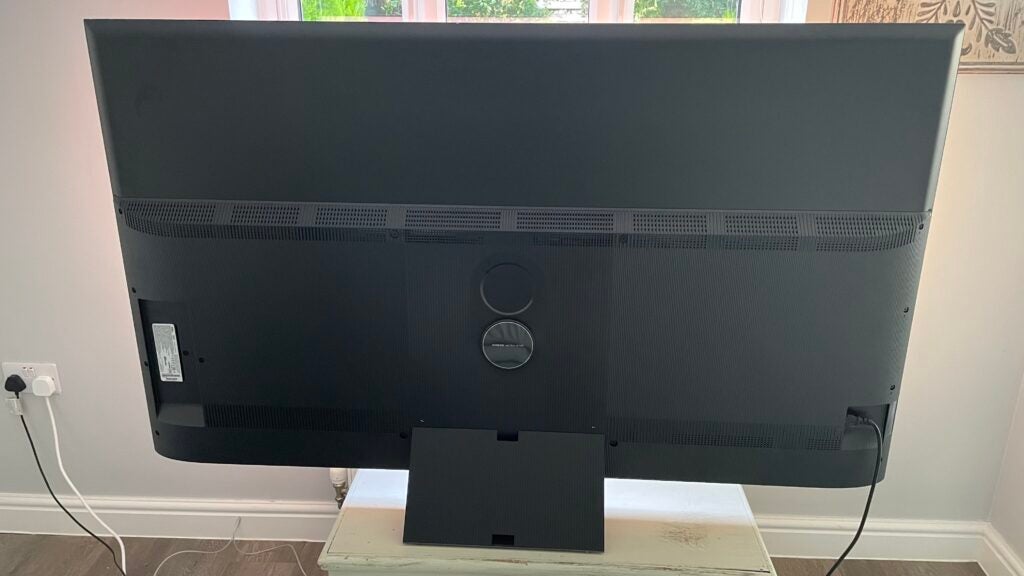
As well as being a potential function of its direct LED lighting engine, the 65C845K’s chunkiness also provides space for a large rear-mounted subwoofer arrangement that forms part of an Onkyo-designed 2.1 speaker system.
The 65C845K’s remote control is a bit cheap and cheerful for such a well-specified TV, featuring plasticky build quality and a rather old-school, button-heavy layout only alleviated by six direct app buttons at the bottom for Netflix, Prime Video, YouTube, a Web browser, the TCL Channel, and the TCL home page.
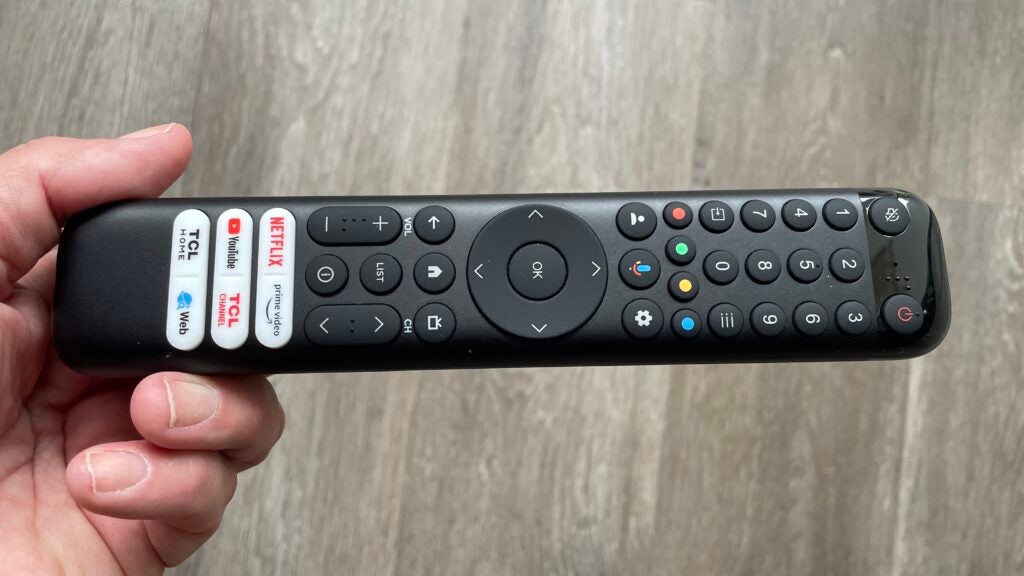
Features
- 4K resolution
- Mini LED lighting with local dimming
- Comprehensive gaming support
The TCL 65C845K’s specifications and features read pretty much like a tick list of stuff you’d feel grateful to find on a TV costing £2,500 or more. The biggest headline grabber is its Mini LED lighting system.
This feature uses much smaller LED lights than those found on regular LED TVs so that more of them can be fitted into the same screen area, offering potentially significant improvements in brightness and contrast. Especially when partnered, as in the 65C84K’s case, by local dimming technology, where different sectors of the backlight can simultaneously output different amounts of brightness to suit the local light demands of any given image frame.
The level to which local dimming can control where light goes in an LCD TV image depends in part on the number of dimming zones a particular TV supports. So it’s pretty exciting to find the 65C845K sporting 576 separately controllable zones – a number that would usually, again, come with a much higher price attached than £1,049.
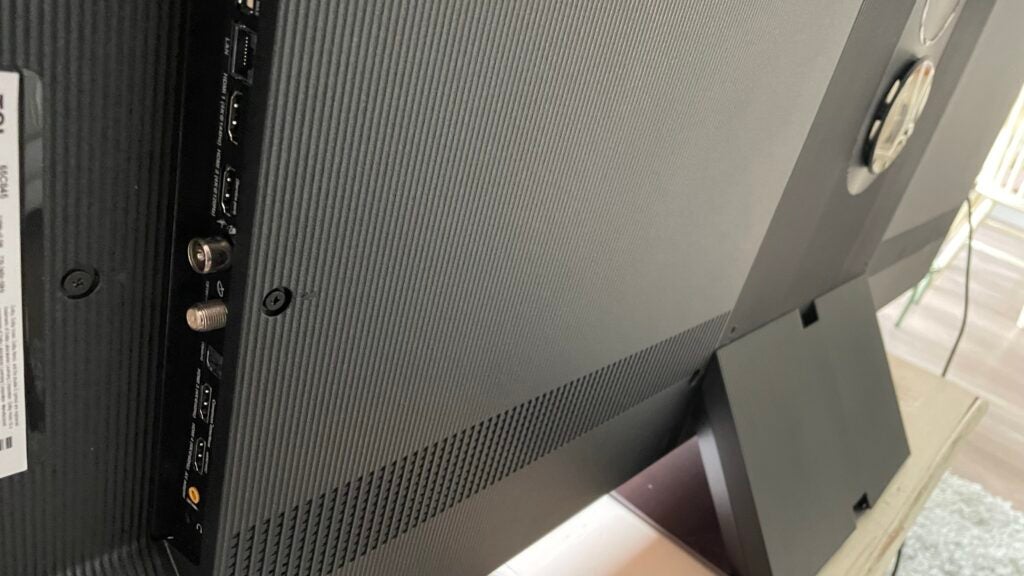
Continuing the 65C845K’s big specs/little price game is a claimed 2000 nits of brightness. This would be another unprecedented figure for such an affordable 65-inch TV, but actually my own measurements of more than 2,200 nits on a 10% HDR window across multiple presets show TCL’s claims to actually be conservative. Even high-end (and so far more expensive) Samsung and Sony models struggle to get beyond that.
Brightness levels as high as those delivered by the 65C845K have the potential to leave colours looking rather thin and bleached if they’re not accompanied by a wide gamut panel. Which is why it’s good to find the 65C845K continuing to make a nonsense of its price by sporting a Quantum Dot colour system that should be capable of handling high luminance levels without desaturating much more effectively than traditional RGB filters.
Yet another pleasant surprise for the TCL 65C845K’s money is its level of gaming support. In fact, two of its four HDMI connections prove capable of handling all the latest features high end console and PC gamers are looking for, including support for 4K/120Hz graphics, variable refresh rates (AMD FreeSync as well as the standard HDMI VRR), auto game mode switching, a Game mode that works with Dolby Vision HDR gaming feeds, and a dedicated Game Master Pro 2.0 interface that comes up in place of the standard video menus when a game source is detected.
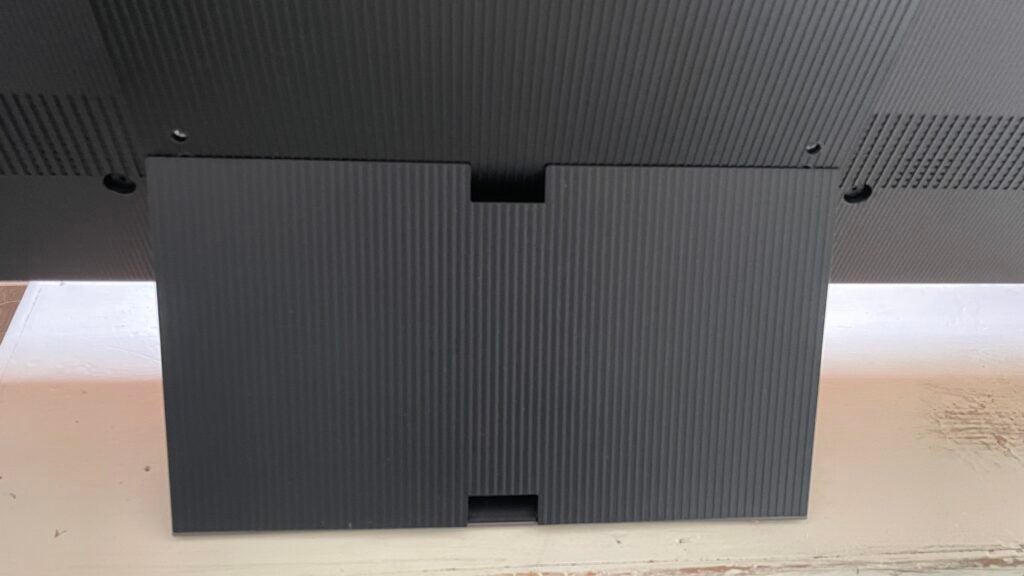
This interface provides a few helpful gaming extras such as a superimposed Aiming Aid, the option to boost the brightness of dark image areas to help you spot lurking enemies, and a series of themed game picture presets.
Dolby Vision HDR is backed up by support for not just the ‘basic’ HDR formats of HDR10 and HLG, but also the Dolby Vision-rivalling HDR10+. Light sensors built into the TV even enable it to support the versions of Dolby Vision and HDR10+ that can respond to ambient light conditions, too. In other words, the TCL 65C845K becomes the latest in a thankfully growing roster of TVs that supports all the HDR formats you’re likely to come across in today’s AV world.
The 65C845K’s support for ‘third party’ formats doesn’t stop there, as it’s also received the formal IMAX Enhanced seal of approval. This means IMAX has judged it up to the job of doing justice to streamed movies and 4K Blu-rays that have been created using the special IMAX Enhanced mastering system.
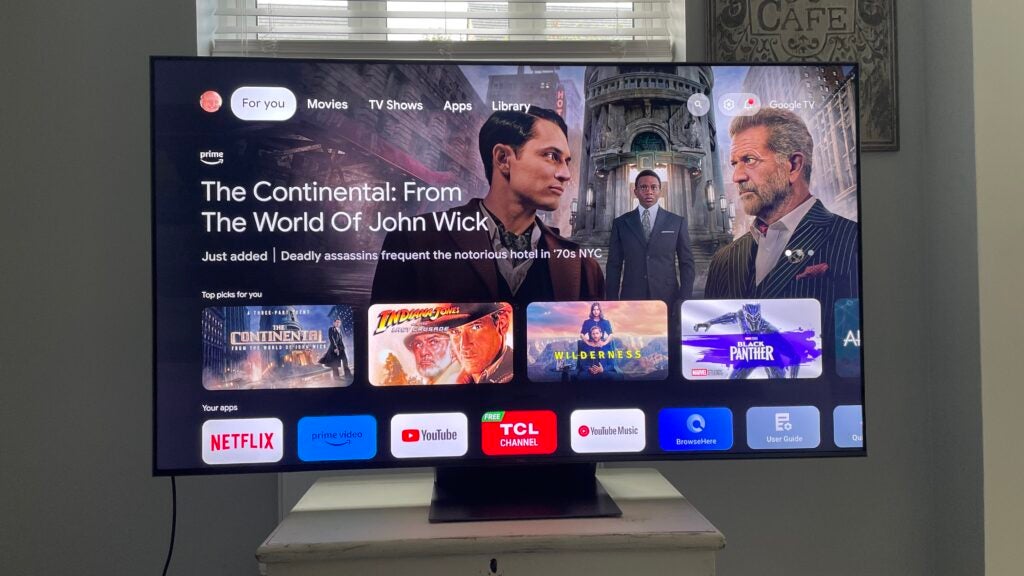
Wrapping up the set’s truly impressive feature count are a 70W, 2.1-channel speaker system with a hefty ‘floating’ subwoofer designed with the audio gurus at Onkyo; TCL’s AIPQ 3.0 processor that draws on AI/machine learning to enhance picture performance; and the Google TV smart system.
Google TV is a much more attractive and well organised upgrade on its Android TV predecessor, but does currently have issues with covering some of the key catch up TV services UK TV buyers now expect. TCL helpfully offers a way round these issues, though, by committing to sending UK buyers a free Roku smart stick if they request one.
Picture Quality
- Spectacularly bright
- Impressive light control
- Presets could be better
Pretty much everything about the TCL 65C845K up to this point has been a case of a TV punching well above its price weight – and happily this trend continues with its picture quality.
The first thing that strikes me like a ray of sunshine from the budget TV gloom is how incredibly bright its pictures are. That 2200+ nits of measured brightness feeds fully into real world (rather than test signal) HDR images, making daylight sequences feel like genuine daylight, and bright highlights look like real moons, streetlights, suns, metallic reflections etc have somehow found their way inside your TV.
The brightness the 65C845K can deliver with full screen bright imagery is particularly gratifying to see on such an affordable TV, delivering a fantastically full-blooded feel to the HDR experience that goes way beyond anything I’ve seen from any other similarly affordable 65-inch TV and even outshines OLED technology in the sense that most OLED TVs struggle to get above 200 nits of brightness with full screen bright images.
OLED screens with their self-emissive pixels can deliver local contrast more effectively than any LED TV. The 65C845K’s 576 local dimming zones, however, manage to control where its blinding light goes much more successfully than you’d have thought possible for its price point.
Dark parts of HDR pictures enjoy typically deep, convincing and consistent black colours that provide a highly effective counterpoint to all of the screen’s effervescent brightness. Or to put it more simply, the 65C845K achieves an unprecedented contrast range for its level of the market, further emphasising its HDR talents. The true beauty of HDR is as much about dark picture areas as bright ones).
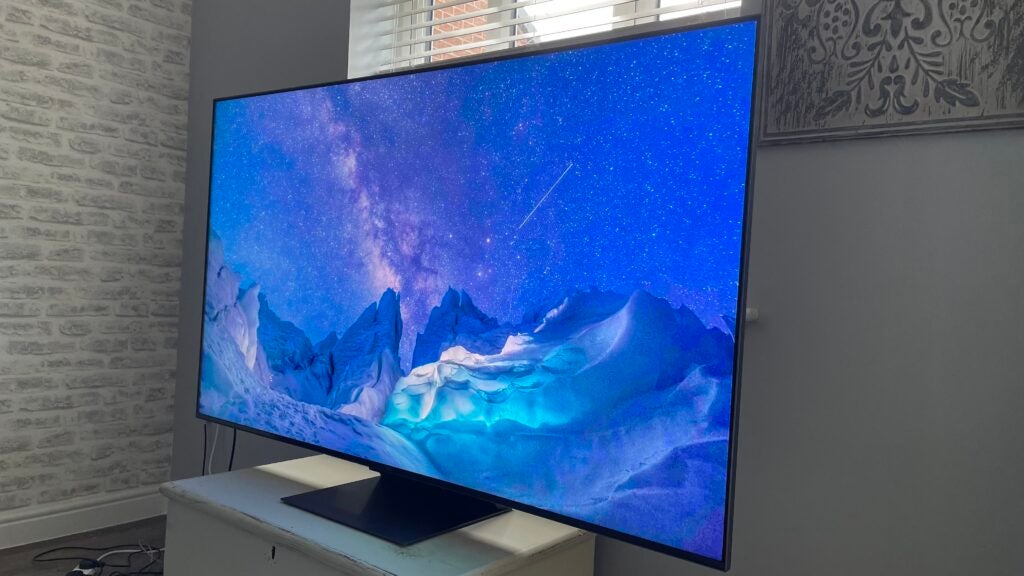
Even better, it delivers this startling contrast with striking consistency. It doesn’t dim bright standout highlights as much as Samsung Mini LED TVs do to limit backlight blooming interference, but nor does it typically suffer as much with backlight clouding and blooming as other locally dimmed TV in its class.
The results of this combination of brightness and contrast contribute to far and away the most cinematic and high-end feeling image I’ve seen from a UK TCL TV, and actually the most aggressive HDR-friendly image I’ve seen from any TV at its price point.
The 65C845K isn’t shy about using all the brightness and contrast at its disposal to deliver another ground-breaking picture achievement: The most vivid, voluminous colourscape we’ve seen on such an affordable 65-inch screen. There’s no hint of the faded, washed out tones that you get with TVs that push brightness alone without bothering to back it up with a strong colour system.
As if the 65C845K hasn’t already done enough to look insanely good value, its pictures are also for the most part exceptionally crisp and detailed. This is every inch a 4K experience, and one that holds up reasonably if not spectacularly well, when there’s lots of motion in a scene. Provided, anyway, you’ve toned down the TV’s motion processing system from its messy, unnatural looking default 10 level to its slightly juddery but overall cleaner and more cinematic three or four level.
All of the picture strengths I’ve described so far also help the 65C845K to be a brilliant gaming display – especially as it backs up the sheer spectacle of its bright, colourful and sharp pictures with an impressively low 60Hz input lag measurement of just over 15ms (and this pretty much halves with 120Hz games).
The suggestion earlier about tweaking the 65C845K’s motion processing is far from the only manual intervention I’d recommend you make to the 65C845K to get the best from it. All of the TV’s presets have varying mixtures of things wrong with them in their out of the box state, requiring you to engage with the TV’s not always totally straightforward set up menus more than you might like.
For instance, in the Standard picture preset the dazzling colours can be too dazzling, tipping over at times into a rather cartoonish, unbalanced look. So if you like the Standard preset generally, you ought to turn off the 65C845K’s Dynamic Colour setting to give it a more immersive, consistent look.
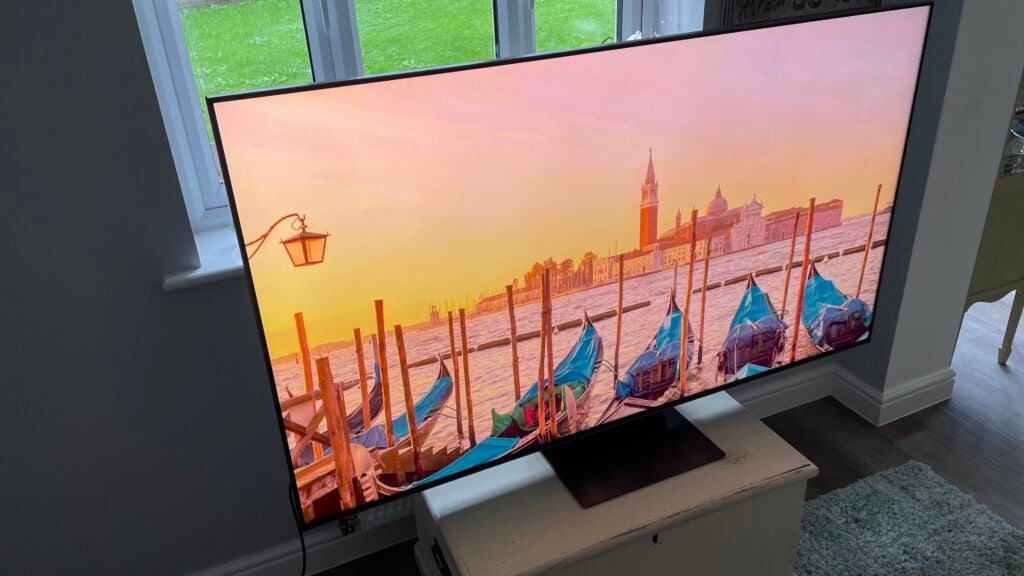
The heavy colour saturation can cause pictures to look a touch noisy across some presets too, so I’d recommend you leave the TV’s noise reduction active (though only on its Low setting) even for 4K sources. Despite this causing a slightly soft look in some picture areas.
You need to have the local dimming system set to High for all presets, as otherwise the excellent black levels take quite a hit. Even though the High setting occasionally – and I do mean occasionally – causes dark scenes to exhibit some over-aggressive adjustments to some of the local dimming zones.
Another set up tip to try in your quest to optimise the 65C845K’s talents would be using the Movie or IMAX Enhanced presets rather than Standard as your movie-night starting point, as these at least give you a more balanced colour performance off the bat even if they’re not as contrast-rich or vibrant in their default state.
There are a couple of other seemingly untweakable areas where the 65C845K cedes some picture ground to the TV world’s most high-end Mini LED stars. First, the set’s tone mapping processing sometimes leaves some of the brightest white or colour areas looking so bleached of subtle shading and saturations that they no longer look like natural parts of the picture.
Second, HDR images that contain a complex mixture of dark and bright content can sometimes cause the mostly strong local dimming engine to struggle, leaving images looking a little patchy and misty as the TV struggles to work out the optimal blend for its dimming zones.
With most out of the box niggles with the 65C845K’s pictures fixable via the picture set up menus, the fact that the 65C845K leaves a little wiggle room for much more expensive Mini LED TVs to claim a picture quality advantage, though, in truth barely detracts at all from the simple fact that its pictures are almost stupidly good for its money.
Sound Quality
- Impressive amounts of bass
- Extreme volumes by TV standards
- Dolby Atmos and DTS Virtual:X decoding
The 65C845K’s sound is as aggressive as its pictures – which is mostly a very good thing. Its 70W of power is given full rein to pump out seriously loud, cinematic volume levels by integrated TV sound system standards. The volume is joined by decent projection, too, to create a sound stage that spreads way beyond the physical boundaries of the TV’s bodywork.
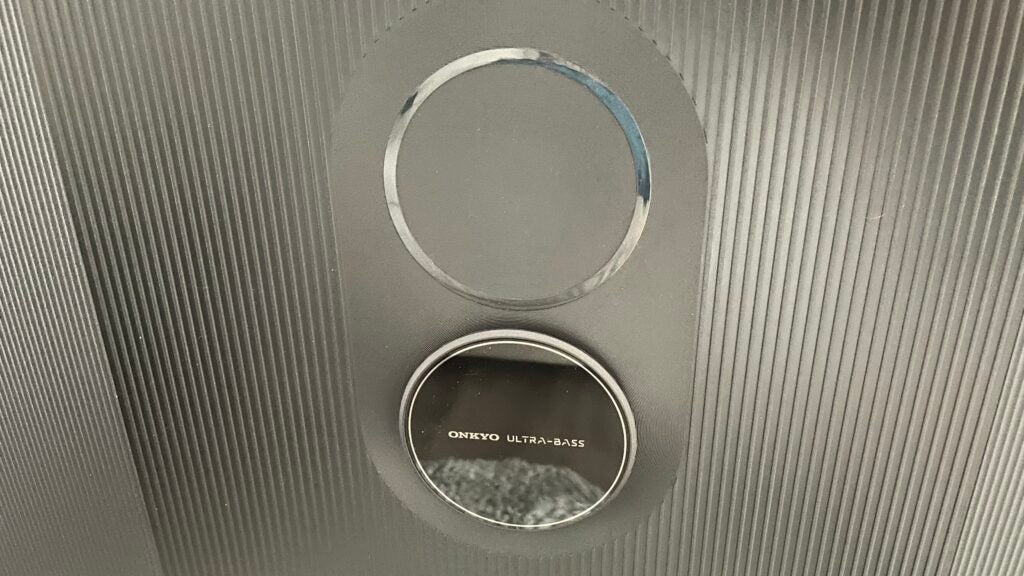
The speakers are able to handle the volume comfortably enough to retain plenty of clean, well placed details, too, as well as pretty much always retaining enough headroom to keep expanding to accommodate swelling action scenes.
Dialogue is clean too, while that impressive looking subwoofer on the TV’s rear contributes strikingly potent and deep rumble effects.
As with its pictures, the 65C845K’s audio exuberance can occasionally go a bit far, causing the sound to become a little coarse during particularly loud moments. A few extreme bass tracks cause the subwoofer to crackle and buzz from time to time too, and sometimes the TV’s bid to create a far-reaching sound stage can cause soundtrack elements to become a little dislocated from each other. Overall, though, its sound actually humbles that of many TVs costing many times more.
Latest deals
Should you buy it?
It’s the best value TV of the year
The level of specification and performance the 65C845K delivers for its money is ridiculous, honestly.
It needs to be set up with care
The 65C845K’s picture presets all have issues, so you need to spend some time learning your way round the TV’s manual picture set up options.
Final Thoughts
The 65C845K is that rarest of things in today’s TV world: a truly disruptive product that redefines with its enormous brightness, excellent contrast and bold, vibrant colours the sort of specifications and performance I might expect from a £1,000 or so 65-inch TV.
This makes it pretty much by default the best value TV of the year – but it will also surely be the source of some serious soul-searching by the TV world’s longer-established brands as they put together their 2024 TV plans.
How we test
We test every television we review thoroughly over an extended period of time. We use industry standard tests to compare features properly. We’ll always tell you what we find. We never, ever, accept money to review a product.
Find out more about how we test in our ethics policy.
Tested for more than a week
Tested with real world use
Tested with benchmarked tests
FAQs
A TV that uses much smaller LEDs than regular LED TVs, to help the screen enjoy better local light control.
Small particles of different sizes that produce different colour frequencies when light is shone through them.
A way of getting more contrast from LCD TVs by dividing the LEDs into multiple, separately controlled zones so different amounts of light can be delivered to different parts of the screen for any given image frame.
Verdict
Tiny LEDs, hundreds of dimming zones and thousands of nits of brightness add up to make the TCL C845K on 2023’s best value TVs
Pros
- Incredibly bright for its money
- Impressive contrast for such a bright screen
- Amazingly affordable for so much quality
Cons
- Local dimming system isn’t flawless
- Picture presets need tweaking
- Built-in subwoofer occasionally distorts
-
65-inch 4K LCD screenThe screen carries 3840 x 2160 pixels. It can also show HD content via an AI-driven upscaling engine -
Mini LED LightingMore LEDs can fit in the same screen area to provide more brightness and light control. -
Google TV with Roku stick on requestSupports Google TV, no UK catch-up services so TCL will send a free Roku stick to any who requests one
Introduction
The TCL 65C845K is the stuff of nightmares for the TV ‘establishment’. After all, its 65-inch screen combines premium Mini LED technology with a Quantum Dot colour system and the sort of local dimming zone and brightness numbers you’d normally have to spend a small fortune for, yet only costs £1,049. No other brand can currently offers any TV that’s remotely similar in spec for anywhere near as little money.
All those rival brands can hope for, really, is that the 65C845K’s ground-breaking specifications for its money don’t translate into the sort of performance level I’d normally expect them to.
Availability
In case you haven’t got the point yet, the 65C845K’s price is unprecedented for the level of specification it offers. At £1,049 in the UK and $2,199 in Australia (there’s no direct equivalent for it in the US), it’s more than £500 cheaper than Samsung’s cheapest 65-inch Mini LED TV, £500 cheaper than the most equivalent Hisense Mini LED TV, and more than £1,300 cheaper than Sony’s 65-inch X95L Mini LED TV for 2023.
There are also 55-, 75- and 85-inch C845Ks available, priced at £849, £1,499 and £1,999 respectively. Note that these other sizes likely won’t feature exactly the same specifications as the 65-inch when it comes to dimming zone numbers and brightness.
Making the 65C845K’s price advantage all the more startling is the fact that despite its affordability, it doesn’t just pay lip service to its premium features. Rather, it actually delivers eye-catchingly high-end versions of those features.
Design
- Pretty chunky by today’s standards
- Heavy duty build
- Centrally mounted stand
If you like your TVs skinny, then the TCL 65C845K isn’t for you. At its deepest point – which is basically almost the whole of its bottom half – it sticks out a prodigious 76mm. Enough to make it a challenging option for wall mounting, even though the screen isn’t as heavy as it looks.
The border round the screen is mercifully slim relative to its depth, and its heavy duty, centrally mounted stand supports the slightly plasticky screen pretty robustly. The stand features a detachable cover on the rear of its neck, too, so that you can hide cables in it.

As well as being a potential function of its direct LED lighting engine, the 65C845K’s chunkiness also provides space for a large rear-mounted subwoofer arrangement that forms part of an Onkyo-designed 2.1 speaker system.
The 65C845K’s remote control is a bit cheap and cheerful for such a well-specified TV, featuring plasticky build quality and a rather old-school, button-heavy layout only alleviated by six direct app buttons at the bottom for Netflix, Prime Video, YouTube, a Web browser, the TCL Channel, and the TCL home page.

Features
- 4K resolution
- Mini LED lighting with local dimming
- Comprehensive gaming support
The TCL 65C845K’s specifications and features read pretty much like a tick list of stuff you’d feel grateful to find on a TV costing £2,500 or more. The biggest headline grabber is its Mini LED lighting system.
This feature uses much smaller LED lights than those found on regular LED TVs so that more of them can be fitted into the same screen area, offering potentially significant improvements in brightness and contrast. Especially when partnered, as in the 65C84K’s case, by local dimming technology, where different sectors of the backlight can simultaneously output different amounts of brightness to suit the local light demands of any given image frame.
The level to which local dimming can control where light goes in an LCD TV image depends in part on the number of dimming zones a particular TV supports. So it’s pretty exciting to find the 65C845K sporting 576 separately controllable zones – a number that would usually, again, come with a much higher price attached than £1,049.

Continuing the 65C845K’s big specs/little price game is a claimed 2000 nits of brightness. This would be another unprecedented figure for such an affordable 65-inch TV, but actually my own measurements of more than 2,200 nits on a 10% HDR window across multiple presets show TCL’s claims to actually be conservative. Even high-end (and so far more expensive) Samsung and Sony models struggle to get beyond that.
Brightness levels as high as those delivered by the 65C845K have the potential to leave colours looking rather thin and bleached if they’re not accompanied by a wide gamut panel. Which is why it’s good to find the 65C845K continuing to make a nonsense of its price by sporting a Quantum Dot colour system that should be capable of handling high luminance levels without desaturating much more effectively than traditional RGB filters.
Yet another pleasant surprise for the TCL 65C845K’s money is its level of gaming support. In fact, two of its four HDMI connections prove capable of handling all the latest features high end console and PC gamers are looking for, including support for 4K/120Hz graphics, variable refresh rates (AMD FreeSync as well as the standard HDMI VRR), auto game mode switching, a Game mode that works with Dolby Vision HDR gaming feeds, and a dedicated Game Master Pro 2.0 interface that comes up in place of the standard video menus when a game source is detected.

This interface provides a few helpful gaming extras such as a superimposed Aiming Aid, the option to boost the brightness of dark image areas to help you spot lurking enemies, and a series of themed game picture presets.
Dolby Vision HDR is backed up by support for not just the ‘basic’ HDR formats of HDR10 and HLG, but also the Dolby Vision-rivalling HDR10+. Light sensors built into the TV even enable it to support the versions of Dolby Vision and HDR10+ that can respond to ambient light conditions, too. In other words, the TCL 65C845K becomes the latest in a thankfully growing roster of TVs that supports all the HDR formats you’re likely to come across in today’s AV world.
The 65C845K’s support for ‘third party’ formats doesn’t stop there, as it’s also received the formal IMAX Enhanced seal of approval. This means IMAX has judged it up to the job of doing justice to streamed movies and 4K Blu-rays that have been created using the special IMAX Enhanced mastering system.

Wrapping up the set’s truly impressive feature count are a 70W, 2.1-channel speaker system with a hefty ‘floating’ subwoofer designed with the audio gurus at Onkyo; TCL’s AIPQ 3.0 processor that draws on AI/machine learning to enhance picture performance; and the Google TV smart system.
Google TV is a much more attractive and well organised upgrade on its Android TV predecessor, but does currently have issues with covering some of the key catch up TV services UK TV buyers now expect. TCL helpfully offers a way round these issues, though, by committing to sending UK buyers a free Roku smart stick if they request one.
Picture Quality
- Spectacularly bright
- Impressive light control
- Presets could be better
Pretty much everything about the TCL 65C845K up to this point has been a case of a TV punching well above its price weight – and happily this trend continues with its picture quality.
The first thing that strikes me like a ray of sunshine from the budget TV gloom is how incredibly bright its pictures are. That 2200+ nits of measured brightness feeds fully into real world (rather than test signal) HDR images, making daylight sequences feel like genuine daylight, and bright highlights look like real moons, streetlights, suns, metallic reflections etc have somehow found their way inside your TV.
The brightness the 65C845K can deliver with full screen bright imagery is particularly gratifying to see on such an affordable TV, delivering a fantastically full-blooded feel to the HDR experience that goes way beyond anything I’ve seen from any other similarly affordable 65-inch TV and even outshines OLED technology in the sense that most OLED TVs struggle to get above 200 nits of brightness with full screen bright images.
OLED screens with their self-emissive pixels can deliver local contrast more effectively than any LED TV. The 65C845K’s 576 local dimming zones, however, manage to control where its blinding light goes much more successfully than you’d have thought possible for its price point.
Dark parts of HDR pictures enjoy typically deep, convincing and consistent black colours that provide a highly effective counterpoint to all of the screen’s effervescent brightness. Or to put it more simply, the 65C845K achieves an unprecedented contrast range for its level of the market, further emphasising its HDR talents. The true beauty of HDR is as much about dark picture areas as bright ones).

Even better, it delivers this startling contrast with striking consistency. It doesn’t dim bright standout highlights as much as Samsung Mini LED TVs do to limit backlight blooming interference, but nor does it typically suffer as much with backlight clouding and blooming as other locally dimmed TV in its class.
The results of this combination of brightness and contrast contribute to far and away the most cinematic and high-end feeling image I’ve seen from a UK TCL TV, and actually the most aggressive HDR-friendly image I’ve seen from any TV at its price point.
The 65C845K isn’t shy about using all the brightness and contrast at its disposal to deliver another ground-breaking picture achievement: The most vivid, voluminous colourscape we’ve seen on such an affordable 65-inch screen. There’s no hint of the faded, washed out tones that you get with TVs that push brightness alone without bothering to back it up with a strong colour system.
As if the 65C845K hasn’t already done enough to look insanely good value, its pictures are also for the most part exceptionally crisp and detailed. This is every inch a 4K experience, and one that holds up reasonably if not spectacularly well, when there’s lots of motion in a scene. Provided, anyway, you’ve toned down the TV’s motion processing system from its messy, unnatural looking default 10 level to its slightly juddery but overall cleaner and more cinematic three or four level.
All of the picture strengths I’ve described so far also help the 65C845K to be a brilliant gaming display – especially as it backs up the sheer spectacle of its bright, colourful and sharp pictures with an impressively low 60Hz input lag measurement of just over 15ms (and this pretty much halves with 120Hz games).
The suggestion earlier about tweaking the 65C845K’s motion processing is far from the only manual intervention I’d recommend you make to the 65C845K to get the best from it. All of the TV’s presets have varying mixtures of things wrong with them in their out of the box state, requiring you to engage with the TV’s not always totally straightforward set up menus more than you might like.
For instance, in the Standard picture preset the dazzling colours can be too dazzling, tipping over at times into a rather cartoonish, unbalanced look. So if you like the Standard preset generally, you ought to turn off the 65C845K’s Dynamic Colour setting to give it a more immersive, consistent look.

The heavy colour saturation can cause pictures to look a touch noisy across some presets too, so I’d recommend you leave the TV’s noise reduction active (though only on its Low setting) even for 4K sources. Despite this causing a slightly soft look in some picture areas.
You need to have the local dimming system set to High for all presets, as otherwise the excellent black levels take quite a hit. Even though the High setting occasionally – and I do mean occasionally – causes dark scenes to exhibit some over-aggressive adjustments to some of the local dimming zones.
Another set up tip to try in your quest to optimise the 65C845K’s talents would be using the Movie or IMAX Enhanced presets rather than Standard as your movie-night starting point, as these at least give you a more balanced colour performance off the bat even if they’re not as contrast-rich or vibrant in their default state.
There are a couple of other seemingly untweakable areas where the 65C845K cedes some picture ground to the TV world’s most high-end Mini LED stars. First, the set’s tone mapping processing sometimes leaves some of the brightest white or colour areas looking so bleached of subtle shading and saturations that they no longer look like natural parts of the picture.
Second, HDR images that contain a complex mixture of dark and bright content can sometimes cause the mostly strong local dimming engine to struggle, leaving images looking a little patchy and misty as the TV struggles to work out the optimal blend for its dimming zones.
With most out of the box niggles with the 65C845K’s pictures fixable via the picture set up menus, the fact that the 65C845K leaves a little wiggle room for much more expensive Mini LED TVs to claim a picture quality advantage, though, in truth barely detracts at all from the simple fact that its pictures are almost stupidly good for its money.
Sound Quality
- Impressive amounts of bass
- Extreme volumes by TV standards
- Dolby Atmos and DTS Virtual:X decoding
The 65C845K’s sound is as aggressive as its pictures – which is mostly a very good thing. Its 70W of power is given full rein to pump out seriously loud, cinematic volume levels by integrated TV sound system standards. The volume is joined by decent projection, too, to create a sound stage that spreads way beyond the physical boundaries of the TV’s bodywork.

The speakers are able to handle the volume comfortably enough to retain plenty of clean, well placed details, too, as well as pretty much always retaining enough headroom to keep expanding to accommodate swelling action scenes.
Dialogue is clean too, while that impressive looking subwoofer on the TV’s rear contributes strikingly potent and deep rumble effects.
As with its pictures, the 65C845K’s audio exuberance can occasionally go a bit far, causing the sound to become a little coarse during particularly loud moments. A few extreme bass tracks cause the subwoofer to crackle and buzz from time to time too, and sometimes the TV’s bid to create a far-reaching sound stage can cause soundtrack elements to become a little dislocated from each other. Overall, though, its sound actually humbles that of many TVs costing many times more.
Latest deals
Should you buy it?
It’s the best value TV of the year
The level of specification and performance the 65C845K delivers for its money is ridiculous, honestly.
It needs to be set up with care
The 65C845K’s picture presets all have issues, so you need to spend some time learning your way round the TV’s manual picture set up options.
Final Thoughts
The 65C845K is that rarest of things in today’s TV world: a truly disruptive product that redefines with its enormous brightness, excellent contrast and bold, vibrant colours the sort of specifications and performance I might expect from a £1,000 or so 65-inch TV.
This makes it pretty much by default the best value TV of the year – but it will also surely be the source of some serious soul-searching by the TV world’s longer-established brands as they put together their 2024 TV plans.
How we test
We test every television we review thoroughly over an extended period of time. We use industry standard tests to compare features properly. We’ll always tell you what we find. We never, ever, accept money to review a product.
Find out more about how we test in our ethics policy.
Tested for more than a week
Tested with real world use
Tested with benchmarked tests
FAQs
A TV that uses much smaller LEDs than regular LED TVs, to help the screen enjoy better local light control.
Small particles of different sizes that produce different colour frequencies when light is shone through them.
A way of getting more contrast from LCD TVs by dividing the LEDs into multiple, separately controlled zones so different amounts of light can be delivered to different parts of the screen for any given image frame.
























